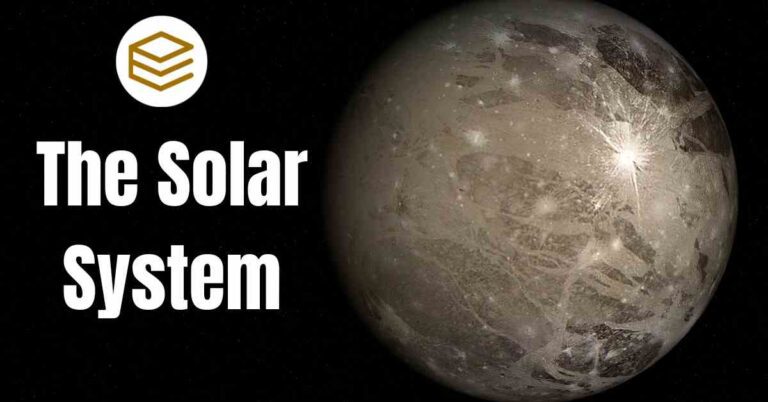October 25, 2025 11:27 am
- Introduction: The Continental Drift Theory was proposed by German meteorologist and geophysicist Alfred Wegener in the 1920s. Wegener suggested that continents were once a single, unified landmass before breaking apart and drifting to their current positions. This concept laid the groundwork for modern plate tectonics, although it faced criticism and skepticism at the time.
- Formation of Landmasses:
- All the continents were once part of a massive supercontinent called Pangea, which was surrounded by a vast, global ocean known as Panthalassa. This configuration persisted until the early Mesozoic era.
- Approximately 200 million years ago, during the Mesozoic era, Pangea began to fragment and separate into smaller landmasses. The breakup of Pangea was driven by the forces within Earth’s interior, which caused the continents to drift apart gradually.
- The Tethys Sea was an important body of water that split Pangea into two enormous landmasses:
- Laurasia: The northern supercontinent, which included present-day North America, Europe, and Asia.
- Gondwanaland: The southern supercontinent, encompassing present-day South America, Africa, Antarctica, Australia, and the Indian subcontinent.
- Over millions of years, Laurasia and Gondwanaland continued to break apart and drift into the continents we recognize today, reshaping Earth’s surface.
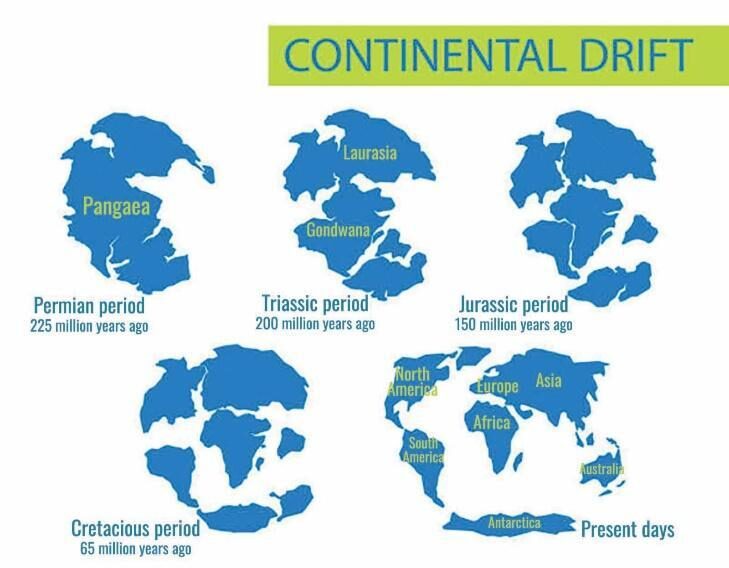
- Continental Drift Directions:
- Wegener proposed that the continents moved in two primary directions:
- Equatorwards: This movement was driven by forces such as gravity, the pole-fleeing force, and buoyancy. The pole-fleeing force is associated with the Earth’s rotation, causing continents to move away from the poles and towards the equator.
- Westwards: This movement was attributed to tidal forces, which are caused by the gravitational pull of the moon and the sun on Earth’s crust.
- Wegener proposed that the continents moved in two primary directions:
- Evidences Given by Wegener:
- Matching of Continents (Jigsaw Fit): The coastlines of continents, like South America and Africa, seem to fit together perfectly, much like pieces of a jigsaw puzzle. For instance, the bulge of Brazil fits neatly into the Gulf of Guinea.
- Rock and Marine Sediment Similarity: Geologists have found that rock formations and marine sediments on different continents are remarkably similar, indicating that these landmasses were once connected.
- Fossil Distribution: Fossils of identical species of plants and animals have been discovered on continents separated by oceans, such as South America and Africa. This suggests that these continents were once joined, allowing species to live in the same environment.
- Tillite Deposits: Tillite is a type of sedimentary rock formed from ancient glacial deposits. The presence of tillite in regions like India, Africa, Falkland Islands, Madagascar, Antarctica, and Australia indicates that these continents were once part of a single, glaciated landmass.
- Rich Placer Deposits of Gold: Gold deposits found along the coast of Ghana (West Africa) have no nearby gold-bearing sources. However, the geological evidence points to the gold-bearing veins located in Brazil. This implies that West Africa and Brazil were once adjacent.
- Polar Wandering: The apparent movement of the poles, as recorded in rocks, suggests that the continents have moved over time. This is now understood to be the result of the movement of tectonic plates.

- Criticisms of Wegener’s Theory:
- Wegener’s explanations for the forces driving continental drift, such as the pole-fleeing force and tidal force, were deemed too weak to account for the movement of continents.
- He could not explain why the drift began specifically in the Mesozoic era and not earlier in Earth’s history.
- The theory did not consider the oceanic crust and focused only on continental landmasses.
- As new geological theories emerged, Continental Drift Theory was overshadowed by the concepts of Sea Floor Spreading and Plate Tectonics, which provided more comprehensive explanations.
LITHOSPHERIC PLATES / PLATE BOUNDARIES / PLATE TECTONICS
- Definition: Tectonic plates are enormous slabs of Earth’s lithosphere that include both continental and oceanic regions. They move and interact with each other, causing geological phenomena such as earthquakes, volcanic eruptions, mountain formation, and the creation of new oceanic crust.
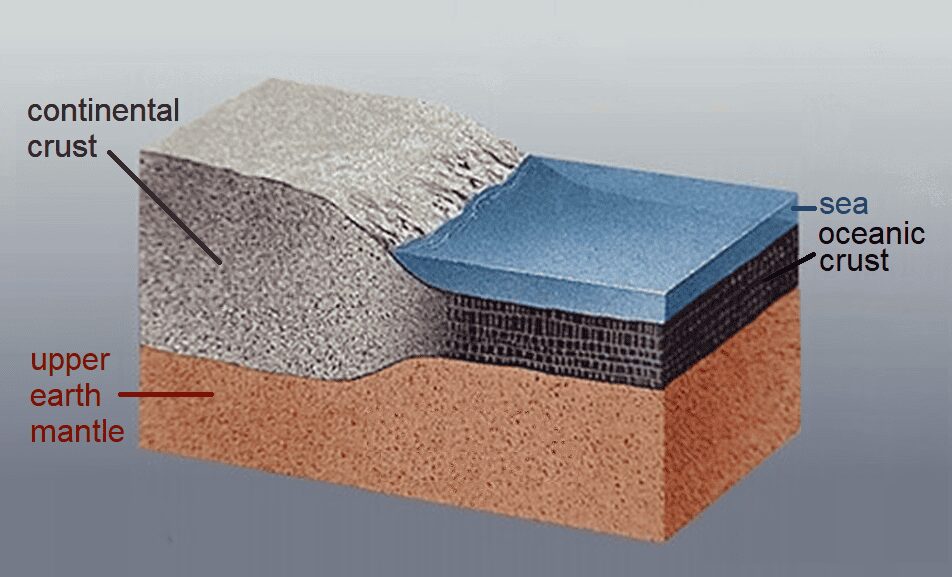
- Lithosphere and Asthenosphere:
- The lithosphere is the rigid outer layer of Earth, consisting of the crust and the uppermost part of the mantle. It is broken into several pieces called tectonic plates.
- These plates float on a semi-fluid layer called the asthenosphere, which is part of the upper mantle. The asthenosphere is ductile and allows the plates to move.
- Convection currents in the mantle, driven by heat from Earth’s interior, cause the plates to drift horizontally.
- Plate Characteristics:
- The thickness of the lithosphere varies:
- Oceanic regions: The lithosphere is thinner, ranging from 5 to 100 km.
- Continental regions: The lithosphere is thicker, up to 200 km.
- Oceanic Plates: These plates consist mainly of dense, basaltic crust (Simatic crust) and are relatively thin.
- Continental Plates: These plates are composed of less dense, granitic crust (Sialic crust) and are thicker.
- The thickness of the lithosphere varies:
- Types of Lithospheric Plates:
- Minor and Major Plates: Plates vary in size, from smaller ones like the Arabian Plate to major plates like the Pacific Plate.
- Continental Plates: Plates that contain large landmasses (e.g., Arabian Plate).
- Oceanic Plates: Plates that are predominantly oceanic (e.g., Pacific Plate).
- Combination Plates: Plates that include both continental and oceanic crust, such as the Indo-Australian Plate.
- Geological Activity at Plate Margins:
- The edges of tectonic plates, or plate boundaries, are sites of intense geological activity. This includes:
- Seafloor Spreading: New crust is created at mid-ocean ridges.
- Volcanic Eruptions: Occur where magma reaches the surface.
- Mountain Building: The collision of continental plates forms mountain ranges.
- Continental Drift: The gradual movement of continents over time.
- The edges of tectonic plates, or plate boundaries, are sites of intense geological activity. This includes:
- Major Tectonic Plates:
- Antarctica Plate: Surrounds Antarctica and is bounded by divergent boundaries.
- North American Plate: Moves westward at a rate of 4-5 cm/year and includes both continental and oceanic crust.
- South American Plate: Moves westward at 3-4 cm/year and is also half continental and half oceanic.
- Pacific Plate: A large, truly oceanic plate that shifts northwest at 2-3 cm/year.
- India-Australia-New Zealand Plate: A complex plate that includes both continental and oceanic regions.
- African Plate: Contains the eastern Atlantic floor and parts of Africa.
- Eurasian Plate: Mostly continental, moving eastward at a rate of 2-3 cm/year.

- Reasons for Tectonic Plate Movements:
- Mantle Dynamics: Convection currents in the mantle, caused by the rising of hot magma and the sinking of cooler material, drive the movement of tectonic plates.
- Heat Sources: Radioactive decay within Earth’s interior and residual heat from the planet’s formation provide energy for mantle convection.
- Mechanisms of Plate Movement:
- Ridge Push: At divergent boundaries, magma pushes up and forces plates apart, creating new crust at mid-ocean ridges.
- Slab Pull: At subduction zones, gravity pulls a subducting plate downward into the mantle, dragging the rest of the plate with it.
Types of Plate Boundaries
- Divergent Boundaries:
- Plates move away from each other, and new crust is formed as magma rises to the surface.
- Example: The Mid-Atlantic Ridge, where the American Plate is separating from the Eurasian and African Plates.
- Features:
- Mid-Ocean Ridges: Underwater mountain ranges.
- Rift Valleys: Depressions formed where plates are pulling apart.
- Fissure Volcanoes: Volcanoes that form along cracks where plates are separating.
- Convergent Boundaries:
- Plates collide, and one plate is often forced beneath the other in a process called subduction.
- Types of Collisions:
- Ocean-Ocean (O-O) Collision: The denser oceanic plate is subducted under the lighter one, forming volcanic island chains.
- Ocean-Continent (O-C) Collision: The oceanic plate is subducted under the continental plate, creating deep ocean trenches and volcanic mountain ranges.
- Continent-Continent (C-C) Collision: When two continental plates collide, they create massive mountain ranges with intense folding and faulting. Earthquakes are frequent in these areas.
- Transform Boundaries:
- Plates slide past each other horizontally, and crust is neither created nor destroyed.
- Example: The San Andreas Fault in California, where the Pacific Plate slides past the North American Plate.
- Features: Earthquakes are common along transform boundaries due to the build-up and sudden release of energy.

Comparison: Continental Drift, Sea Floor Spreading, and Plate Tectonics
- Continental Drift:
- Explanation: Proposed by Alfred Wegener in the 1920s, Continental Drift Theory explained only the movement of continents over Earth’s surface. It suggested that continents were once joined together as a supercontinent (Pangea) and later drifted apart.
- Driving Forces: Wegener believed that buoyancy, gravity, pole-fleeing force, and tidal forces were responsible for moving continents. However, these forces were considered inadequate by many scientists of the time.
- Evidence: Wegener’s theory was supported by apparent physical connections between continents, similarities in fossil records, glacial deposits, and rocks of the same age across continents. For example:
- Apparent Fit of Continents: The coastlines of South America and Africa fit like pieces of a puzzle.
- Fossil Evidence: Fossils of Mesosaurus (a small, freshwater reptile) found in both South America and Africa suggest these continents were once connected.
- Geological Evidence: Tillite deposits and rock formations provided further proof of continental connectivity.
- Drawbacks: Despite the evidence, the theory lacked a plausible mechanism to explain the movement of continents. The idea of tidal and pole-fleeing forces was largely dismissed as unrealistic.
- Sea Floor Spreading:
- Explanation: Developed in the 1940s and 1950s, this theory was based on the work of Harry Hess and others. It explained the formation of new oceanic crust at mid-ocean ridges and the symmetrical spreading of the sea floor on either side.
- Driving Forces: The movement of oceanic plates is driven by convection currents in the mantle. Magma rises at mid-ocean ridges, cools to form new crust, and then spreads outward.
- Evidence: Paleomagnetic studies of the ocean floor revealed alternating magnetic stripes, which provided a record of Earth’s magnetic field reversals. These stripes mirrored each other on opposite sides of mid-ocean ridges, confirming the concept of sea floor spreading.
- Key Features:
- Mid-Ocean Ridges: Underwater mountain ranges where new crust is formed.
- Deep Ocean Trenches: Areas where old crust is subducted and recycled into the mantle.
- Impact: Sea Floor Spreading provided a mechanism for the movement of oceanic plates, complementing and strengthening the ideas of Continental Drift.
- Plate Tectonics:
- Explanation: In the 1960s, the theory of Plate Tectonics emerged as a unifying explanation for both continental and oceanic movements. It was developed based on the ideas of John Tuzo Wilson, Dan McKenzie, and others.
- Driving Forces: Plate movements are driven by mantle convection, ridge push, and slab pull. Convection currents in the mantle cause hot magma to rise and spread laterally, moving the plates.
- Evidence: Plate Tectonics Theory is supported by a wide range of geological evidence, including:
- Earthquake and Volcano Distribution: Most earthquakes and volcanoes occur along plate boundaries, such as the Pacific Ring of Fire.
- Paleomagnetism: Magnetic patterns on the ocean floor confirm sea floor spreading.
- Gravitational Anomalies: Variations in gravity near deep ocean trenches and mountain ranges align with plate interactions.
- Acceptance: Plate Tectonics is the most widely accepted theory today and explains the movement of lithospheric plates, the formation of geological features, and the causes of earthquakes and volcanic activity.
Comparison Table: Continental Drift, Sea Floor Spreading, and Plate Tectonics
| Aspect | Continental Drift | Sea Floor Spreading | Plate Tectonics |
|---|---|---|---|
| Proposed By | Alfred Wegener (1920s) | Harry Hess (1940s) | McKenzie, Parker (1967), Morgan (1968) |
| Theory Focus | Movement of continents only | Movement of oceanic plates only | Movement of lithospheric plates (both continents and oceans) |
| Driving Force | Buoyancy, gravity, pole-fleeing force, tidal currents | Convection currents in the mantle | Convection currents in the mantle |
| Evidence | Jigsaw fit of continents, fossil evidence, tillite deposits | Ocean floor topography, magnetic stripes, distribution of earthquakes and volcanoes | Combination of evidence from both theories |
| Drawbacks | Did not explain the movement of oceans | Did not explain the movement of continents | Widely accepted and explains various geological phenomena |
| Significance | Led to the development of new theories | Supported by Plate Tectonics Theory | Helps understand geological features and processes |
FOLD MOUNTAIN OROGENY
- Definition: Fold mountains are created by the process of orogeny, which involves the collision of tectonic plates. This process causes the crust to buckle and fold, forming long, high mountain ranges.
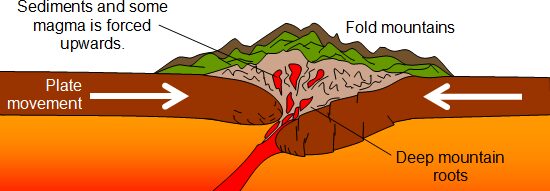
- Formation of the Himalayas:
- Tectonic Collision: The Himalayas were formed as a result of the collision between the Indian Plate and the Eurasian Plate. This tectonic collision began more than 50 million years ago and is still ongoing today.
- Historical Movement:
- Around 80 million years ago, the Indian subcontinent was situated approximately 6,400 km (3,968 miles) south of the Eurasian Plate, with the Tethys Sea lying between them.
- Driven by mantle convection, the Indo-Australian Plate (which includes India) moved northward at a significant pace.
- As India approached the Eurasian Plate, the Tethys Sea began to shrink, and its seabed was pushed upward, forming the initial uplift of the Himalayas.
- Approximately 40 million years ago, the two plates collided, and the sea disappeared completely about 20 million years ago. The collision caused the seabed sediments to rise, creating the massive fold mountains known as the Himalayas.
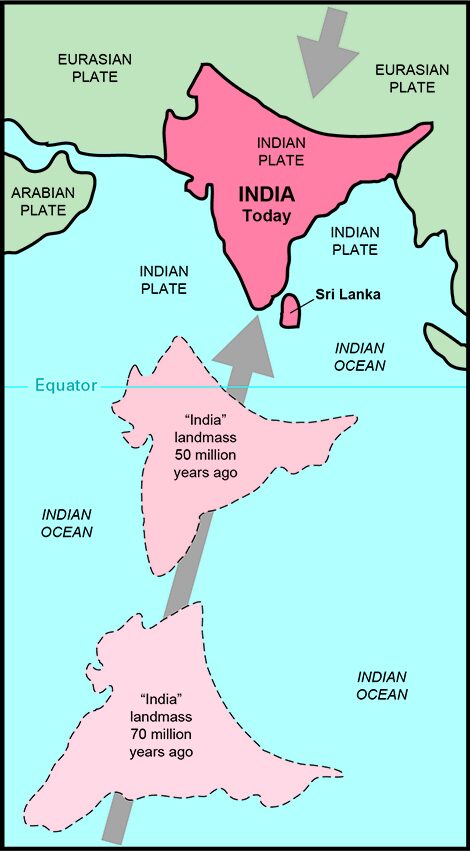
- Continued Uplift: The Himalayas are still rising at a rate of more than 1 cm per year. The ongoing movement of the Indian Plate towards the Eurasian Plate continues to create immense geological pressure, causing earthquakes and further uplift.
- Seismic Activity: The Himalayas are a seismically active region, with frequent earthquakes resulting from the ongoing tectonic collision.
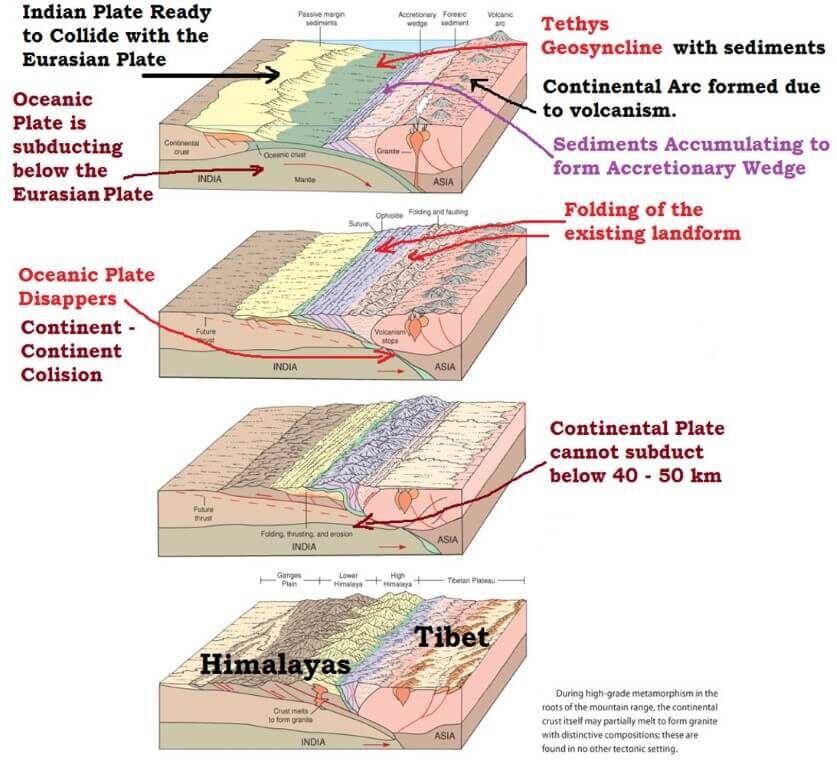
- Evidence for the Rising Himalayas:
- Satellite Data: High-precision satellites equipped with atomic clocks can measure the uplift of the Himalayas, confirming that they continue to rise by a few centimeters every year.
- Desiccated Lakes in Tibet: Ancient lakes in Tibet have dried up, leaving gravel terraces high above the current water levels, indicating ongoing uplift.
- Youthful Rivers: The rivers originating from the Himalayas, such as the Ganges and Brahmaputra, are in their youthful stage, suggesting recent rejuvenation due to the rising landmass.

- Why Fold Mountains Form at Continental Margins:
- Continent-Continent Convergence: When two continental plates collide, such as the Indian and Eurasian Plates, the oceanic sediments between them are compressed and uplifted, forming fold mountains (e.g., Himalayas, Alps).
- Continent-Ocean Convergence: When an oceanic plate collides with a continental plate (e.g., the Andes and the Rockies), the subducting oceanic plate compresses and uplifts the continental crust, forming mountain ranges along the continental margin.
- Association with Earthquakes and Volcanoes:
- Earthquakes: The collision between tectonic plates creates immense friction. When this friction is suddenly released, it causes earthquakes, especially along fault zones where plates interact.
- In Continent-Continent Convergence, shallow-focus earthquakes are common due to the intense pressure between colliding plates.
- In Continent-Ocean Convergence, both shallow and deep-focus earthquakes occur, depending on the depth of subduction.
- Volcanism: Volcanic activity is common in Continent-Ocean Convergence but rare in Continent-Continent Convergence. This is because the thick continental crust prevents magma from escaping to the surface in continent-continent collisions.
- Earthquakes: The collision between tectonic plates creates immense friction. When this friction is suddenly released, it causes earthquakes, especially along fault zones where plates interact.



